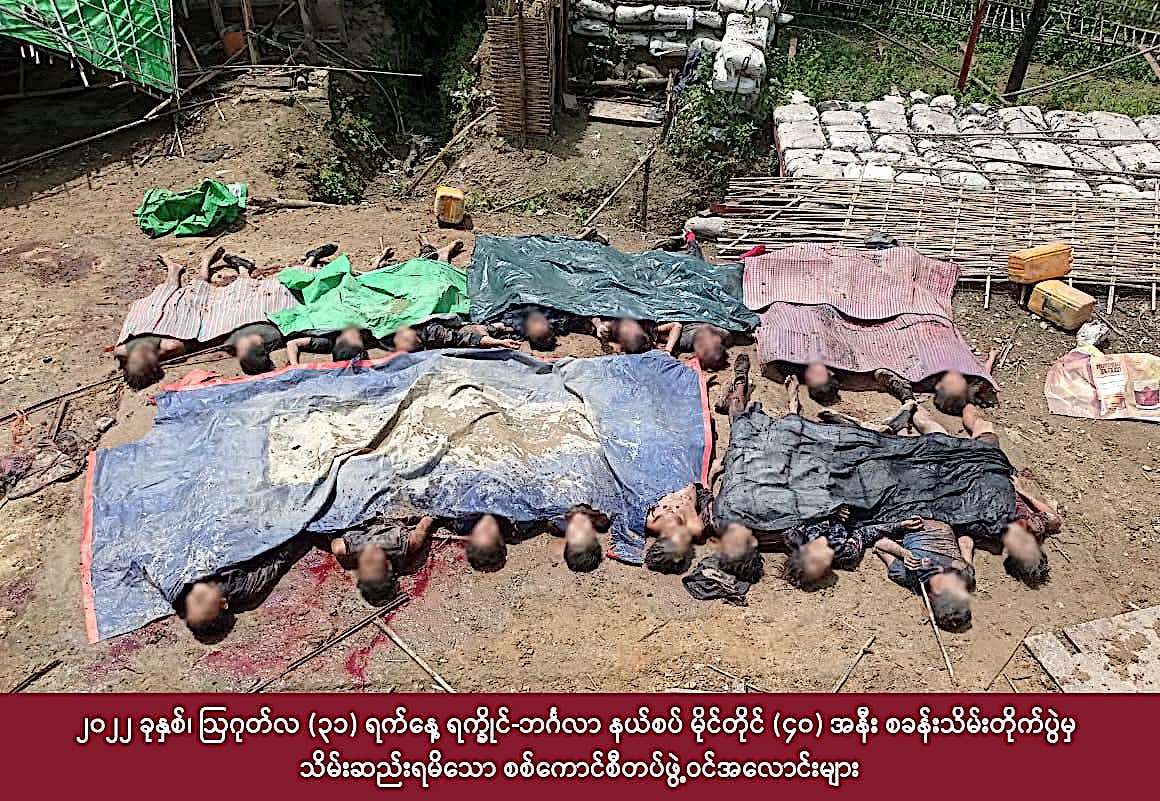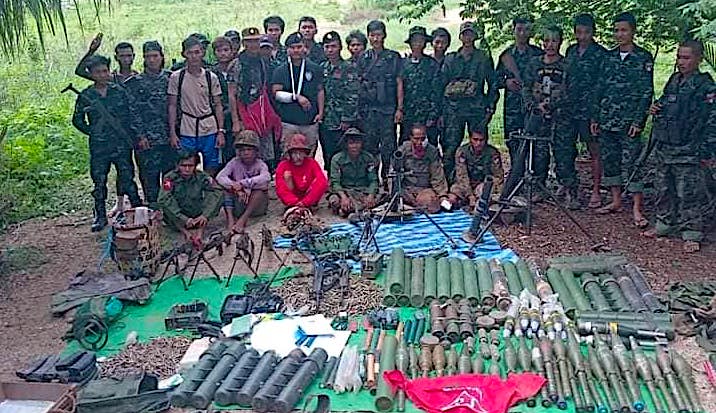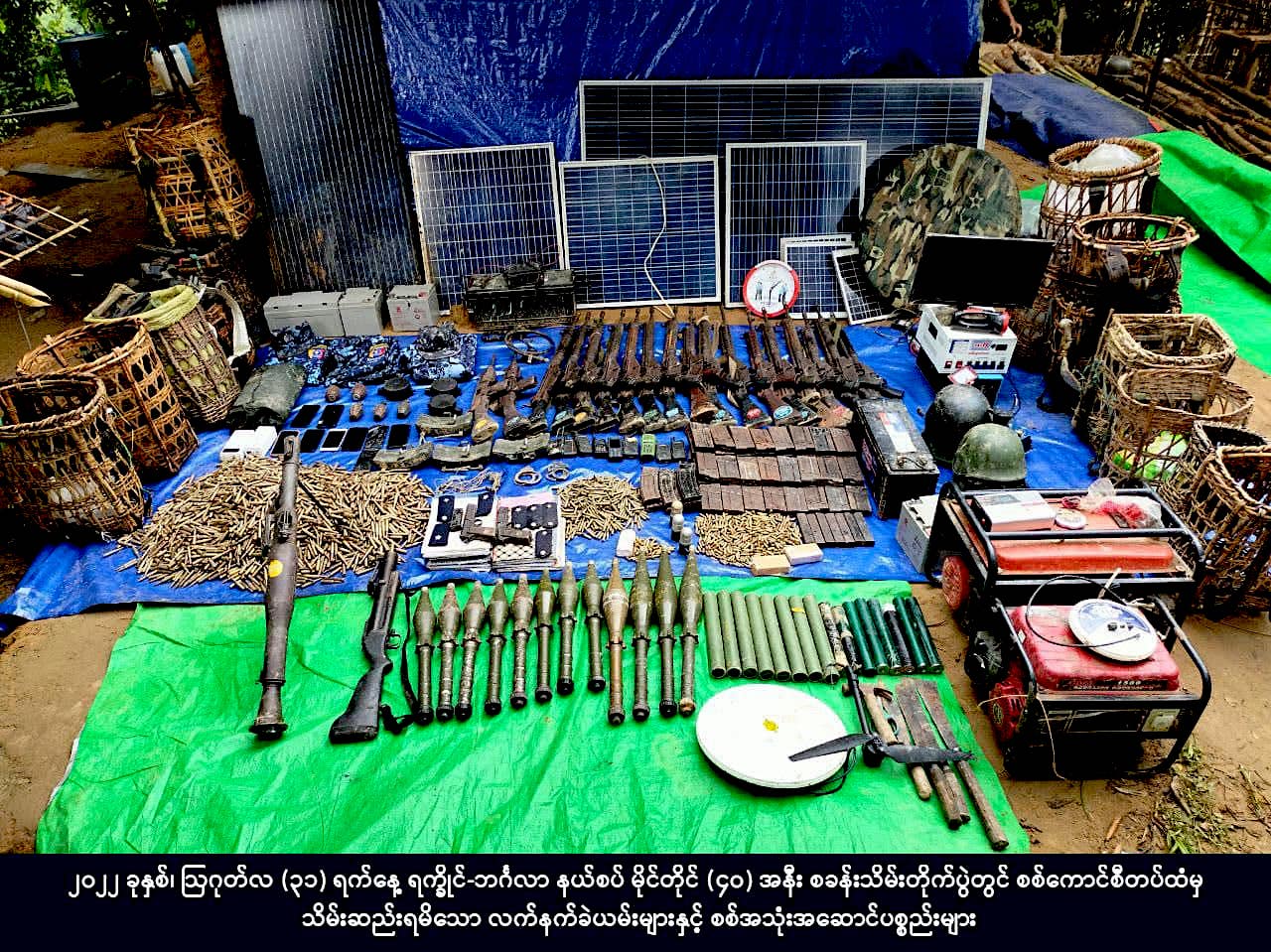Myanmar’s junta has lost nearly 90 bases in 17 months since the coup in fighting with resistance forces and ethnic armed organizations (EAOs), according to armed groups.
They included key outposts in strategic locations or critical bases for the supply of weapons and food to frontline troops.
The regime has lost at least 20 bases in Kachin State, three in Chin State, 19 in Kayah State, 12 in Karen State and 36 in Rakhine State, according to EAOs and conflict monitors.
Kachin State
The Kachin Independence Army (KIA) started its attacks on junta outposts by seizing a hilltop base at Alaw Bun near the Chinese border.
The hill near Dawtphoneyan town in Bhamo District was seized by Myanmar’s military in 1987. The regime in April carried out large-scale attacks, involving helicopters and artillery, to retake the hill but the operation failed.
Later the KIA led Kachin resistance groups to seize more outposts. According to KIA sources, five outposts in Hpakant Township, three in Putao Township, two in Tanai Township, three in Bhamo Township and several outposts in Waingmaw and Shwegu townships were taken.
A KIA source said: “In Shwegu, the KIA didn’t need to attack. Junta troops just withdrew from their outposts.”
Kayah State
The regime has lost 14 bases and five police stations in Kayah State, according to the Karenni National Progressive Party (KNPP), the political wing of the Karenni Army (KA), which is fighting the regime.
KNPP secretary Khu Daniel said KA-led forces seized junta bases and police stations in Mese, Hpasawng, Hpruso, Bawlakhe, Demoso and Shadaw townships.

“Most of the bases that we seized had about 12 soldiers and only two had 30 to 40 personnel. In 2021, we only seized four bases but we took more this year.
“The regime has suffered heavy casualties as it has had to fight on many fronts over the past year. So it abandoned outposts that are not critical. We cut off supply routes making it more difficult for them to retain their camps,” he added.
However, revolutionary forces in Kayah State have only been able to use guerilla warfare and cannot launch frontal attacks on the regime.
“We fear aerial assaults and artillery. They fire shells indiscriminately even though there is no fighting. They have sometimes used multiple rocket launchers. Mostly they drop bombs,” he said.
Chin State
The regime has lost at least three bases in Thantlang and Mindat townships in Chin State, according to conflict monitors.
The Chin National Army and Chinland Defense Force (CDF) seized a junta outpost near the Indian border in Thantlang in September last year. Airstrikes forced more than 1,000 residents to cross the Indian border into Mizoram.
The CDF in Mindat seized a junta outpost held by around 30 soldiers and police in a village southwest of Mindat in July. Police left their station in another village due to resistance attacks. Since then junta troops repeatedly attacked the CDF until December, said the group’s spokesman Salai Hwa Awng.
Junta troops can no longer easily travel by road to Chin State because of the strength of resistance groups fighting the regime in Sagaing and Magwe regions, he said.
“We now control 85 percent of Mindat. The regime controls Mindat town and about three villages near the town. And we have carried out attacks in the town. The last time the junta attacked us was in December,” said the spokesman.
Karen State
The regime has lost at least 12 bases in Karen State and Bago Region, according to the Karen National Union (KNU), which has been fighting the regime in Karen and Mon states and Bago Region.
The regime has lost three bases in Papun District where KNU Brigade 5 is based, and lost two bases, including Thay Baw Boe camp, in areas controlled by KNU Brigade 6.
The KNU-led resistance forces also attacked the Ukayit Hta outpost between Myawaddy and Waw Lay in Karen State in June but failed to seize it due to junta artillery and airstrikes.
The Karen resistance suffered casualties and an estimated 100 junta soldiers died in clashes at the outpost, resistance groups claimed.
The Irrawaddy could not independently verify the reports.
The regime lost its five bases to the KNU in Mone Township, Bago Region, where KNU Brigade 3 is based.

Rakhine State
The regime has lost at least 36 bases in Rakhine State, according to observers.
Around 30 were in Maungdaw Township and six were in Paletwa Township, Chin State, which borders Rakhine State, according to observers.
The Arakan Army (AA) seized five junta outposts in Paletwa in late August while junta troops withdrew from an outpost overlooking the Lemyo River in eastern Paletwa after an AA siege, said an observer.
The AA seized a border police outpost on the Bangladesh border in Maungdaw Township in late August, in which 19 police officers died and many weapons were seized, according to the armed group.
The regime has attempted to retake the outpost, conducting air and artillery attacks. The Bangladeshi authorities summoned Myanmar’s ambassador in Dhaka in early September after shells landed in Bangladesh.
An observer said the regime might have lost even more Rakhine outposts than those claimed by the AA.

Sagaing and Magwe regions
The regime has lost outposts to newly formed resistance groups, many of whom are ethnically Bamar, according to observers, who say they are unsure of the exact numbers.
An observer said: “The regime knew smaller outposts would be attacked and occupied. So it has combined three or four small outposts into a bigger one. Many small police stations have been deserted in Sagaing and Magwe. The regime is undermanned as the resistance forces have grown. It is only trying to control towns and roads and everywhere else falls into rebel hands.”
Regime losing control
The Special Advisory Council for Myanmar, an independent group formed by former United Nations envoys to Myanmar, reported in a briefing paper on September 5 that the regime only has full control over 72 out of the 330 townships.
The civilian National Unity Government and resistance groups have effective control over 52 percent of the country, it said. The junta is being challenged in another 23 percent of the country and can only claim to have stable control over 17 percent of Myanmar, the paper said.
A Myanmar-based analyst said the junta can no longer conduct a large-scale attack with up to 1,000 soldiers and is only concentrating on defense.
“What the junta is doing now is defensive to control cities and transport routes and fight the EAOs that it feels are a threat. That’s all. In Sagaing and Magwe, it mainly controls towns and roads. Elsewhere it only raids villages and torches homes based on tipoffs,” said the analyst.

















